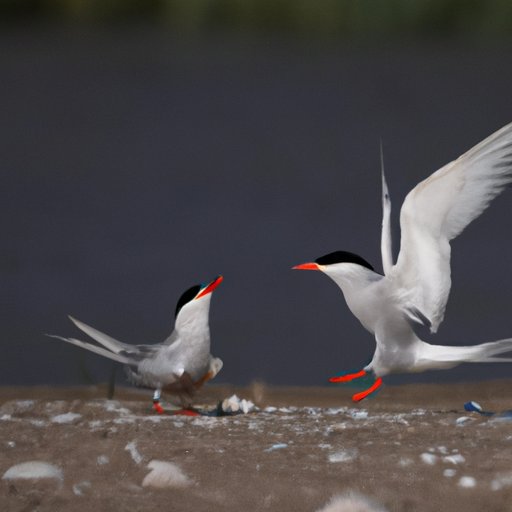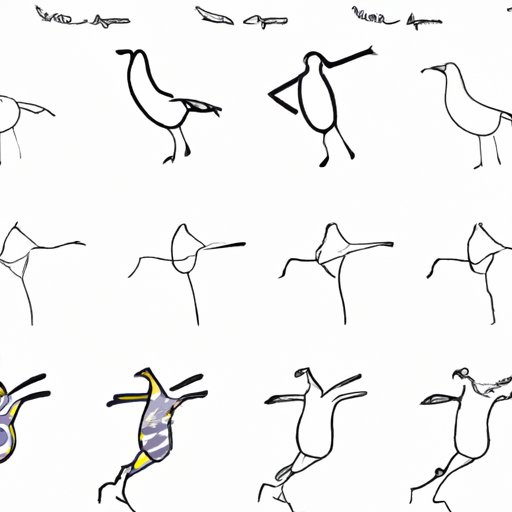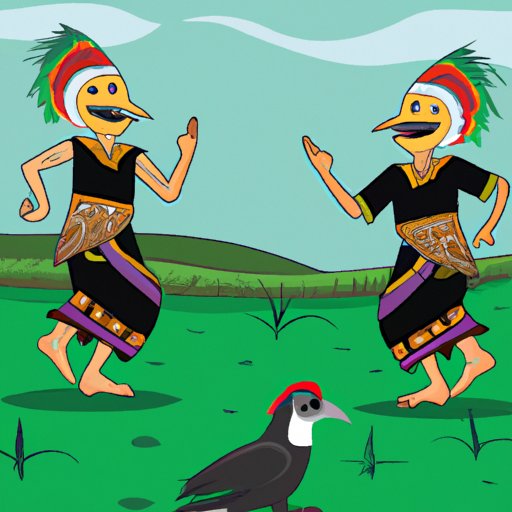Introduction
Bird dancing is a behavior that has been observed across many different species of birds. It is a type of ritualized behavior that involves a combination of movements, vocalizations, and displays that are used to communicate with other birds. Despite its prevalence, scientists are still trying to understand the purpose of this behavior and why certain birds engage in it. This article will explore the science and evolutionary purpose behind bird dancing in order to better understand why birds do it and what role it plays in their lives.
Examining the Science Behind Bird Dancing
When examining the science behind bird dancing, there are two main areas to consider: physiological and behavioral aspects. Physiologically, birds use a variety of body parts and postures to communicate with other birds. For example, some species of birds will spread their wings and tail feathers in order to appear larger and more intimidating. Other species may bow or bob their heads up and down in order to show submission.
Behaviorally, birds use a combination of vocalizations, movements, and displays to communicate with one another. They may sing, call, or chirp to attract potential mates or scare off rivals. They may also engage in courtship dances in order to attract a mate or establish dominance over a territory. These behaviors can vary greatly between species, but they all serve the same purpose of communication.
Exploring the Role of Bird Dancing in Courtship and Mating Rituals
Bird dancing plays an important role in courtship and mating rituals. There are several different types of courtship displays that birds use to attract potential mates. Some birds may perform elaborate aerial displays such as acrobatics or dives. Others may perform more subtle displays such as bowing or bobbing their heads up and down. Still others may use song, calls, or chirps to attract a mate. Regardless of the type of display, these behaviors are designed to demonstrate fitness and strength to potential mates.
In addition to attracting a mate, bird dancing can also benefit mating success by helping to establish a pair bond. Studies have shown that birds who engage in elaborate courtship displays are more likely to form long-term pair bonds than those who do not. This suggests that bird dancing is a critical component of successful mating rituals.
Investigating the Evolutionary Purpose of Bird Dancing
The evolutionary purpose of bird dancing can be traced back to the need to survive predators. By engaging in elaborate displays, birds are able to draw attention away from themselves and onto another bird. This tactic can be used to distract predators or to signal danger to other birds. In addition, by engaging in displays, birds can establish dominance over a territory and defend resources such as food and nesting sites.
Bird dancing can also serve a social purpose. Many species use displays to communicate with one another and to establish social hierarchies. By engaging in displays, birds can send signals about their status and intentions to other members of their species. This allows them to form alliances, establish dominance, and defend territory.

Understanding the Benefits of Bird Dancing for Territorial Disputes
Bird dancing can also be used to settle territorial disputes. By engaging in displays, birds can establish dominance and defend resources. This can be beneficial for both individuals and groups, as it helps to maintain order within a flock and prevent conflict. In addition, it can help to protect valuable resources such as food and nesting sites from competitors.

Analyzing the Different Types of Bird Dances
There are several different types of bird dances that birds use to communicate. Alarm calls are used to warn other birds of danger or to alert them to the presence of a predator. Display flights involve birds flying in large circles or figure eights in order to attract a mate or establish dominance. Bowing is a common display used by birds to show submission or to demonstrate fitness.

Comparing Bird Dancing to Human Dance Traditions
When compared to human dance traditions, bird dancing shares some similarities in terms of form and function. Both involve complex movements and gestures that are used to communicate with others. However, there are also some significant differences. Human dance is often used as a form of expression or entertainment, while bird dancing is primarily used for communication purposes. In addition, human dance often involves cultural elements that are not present in bird dancing.
Conclusion
This article has explored the science and evolutionary purpose behind bird dancing. It has examined the physiological and behavioral aspects of bird dancing and its role in courtship and mating rituals. It has also investigated the benefits of bird dancing for territorial disputes and analyzed the different types of bird dances. Finally, it has compared bird dancing to human dance traditions. Through this exploration, it is clear that bird dancing serves an important purpose in the lives of birds, and further research into the subject could provide valuable insight into the behavior.
(Note: Is this article not meeting your expectations? Do you have knowledge or insights to share? Unlock new opportunities and expand your reach by joining our authors team. Click Registration to join us and share your expertise with our readers.)
